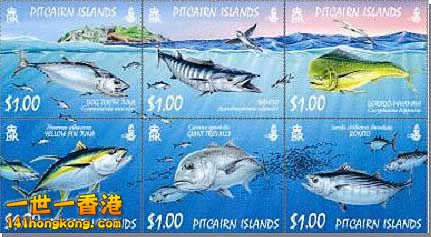|
|
 發表於 2013-11-17 15:50:30
|
顯示全部樓層
發表於 2013-11-17 15:50:30
|
顯示全部樓層
回帖獎勵 +30000 元錢

The Pitcairners rely on harvesting the larger fish as a valuable food source. They usually go fishing for the larger type fish when the weather is calm, but can venture out in winds up to 20km. Trawling is the most popular method and the season is from July-December.


Mostly the trawling is done by smaller boats, although every so often a public fishing day is organised and those fishing take to the longboats. Some people trawl with rods with breaking strain line of up to 30-40kg, but the trawling lines are much stronger, with breaking strains from 300-400kg. Catching the large ocean fish creates much excitement with most larger fish putting up a good battle.
The most common ocean fish caught around Pitcairn are:
Dogtooth Tuna, Gymnosarda unicolor. With their average of 20 conical teeth per jaw, they most resemble sharks. Native to the tropical Indo-West Pacific, Dogtooth tuna are a resident pelagic (open ocean) fish, favouring water 20 to 28º C. Swimming mostly as individuals or in small groups, they frequent depths between 15 and 50 metres. Dogtooth tuna grow up to 20 kg in weight, 1.6m in length and are coloured a brilliant blue to black above and silver below.
Wahoo Acanthocybium solandri, has an elongate body, covered with small, scarcely visible scales. Coloured an iridescent blue green, with silvery sides and a pattern of vertical blue bars, the Wahoo’s large mouth is useful to feed on other fish and squid, Wahoo can swim up to 75 km per hour and hunt alone or in loose-knit groups of two or three. The flesh of the Wahoo is delicate and white and regarded as very good in quality.
Dorado-Mahimahi Coryphaena hippurus. Also known as Dolphin Fish, the Mahimahi, with its crested, round head resembles a dolphin. Strikingly coloured in a mix of gold, metallic blue and green, they grow to over 2 metres in length and up to 40kg in weight. Found in the main oceans, they feed on other fish, zooplankton, crustaceans and squid but only live to around five years
The Yellow Fin Tuna Thunnus albacares, is found in open waters and recognisable by the bright yellow fins and back. The main body is very dark metallic blue, changing to silver on the belly. Eating mostly other fish, crustaceans and squid, Yellow Fins tend to school with fishes of the same size. Yellow Fin tuna are a popular sport fish being prized for their speed and strength. Also commercially popular, they are mainly sold in frozen or canned form.
Giant Trevally Caranx ignobilis can be recognised by its steep head profile and its large size, growing to 1.7m in length and 60kg in weight. Its colouration varies from uniform silvery to almost black and it is found throughout the Indo Pacific. Most individuals of this species aggregate in large schools, while larger individuals tend to be solitary, preferring to feed at night, mostly on baitfish.
Bonito Sarda chiliensis lineolata. Known as the Pacific Bonito around Pitcairn, this fish is a game fighter but which is not highly thought of as a food fish. It is colored blue to violet above, with a metallic luster. It has stripes on its back.and grows to a maximum of just over 100cm in length and 11kg in weight. The Bonito feeds on a variety of small schooling fishes, squids and shrimps.
Ocean Fish
New Zealand Dollars
$1.00 x 6 Single Set
$6.00
First Day Cover $7.00
Technical Details
Designer:
Jean Richard Lisiak, Paris, France Pitcairn Stamps
Printer: Southern Colour Print, Dunedin, New Zealand
Process: Offset Litho
Stamp Size: 45.15mm x 37.5mm
Format: 6 horizontal stamps in setenant blocks
Perforation Gauge: 14.40 x 14.60
Sheet Configuration: 48 stamps per sheet, 2 x panes of 24
Denominations: Stamps $1.00 x 6
Paper: 104g, Tullis Russell, non phosphor, gum paper
Period of Sale:
12 December 2007 for a period of 2 years
|
|



